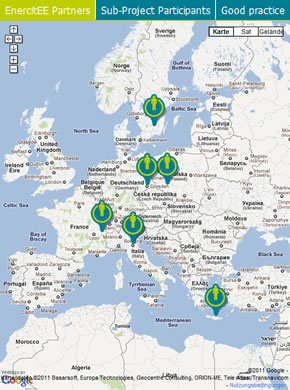Policy maker exchange – mayors from the EnercitEE partner regions will travel to Växjö, Sweden
From 30 May to 01 June 2012 the city of Växjö in Smaland, Sweden welcomes interested mayors from the different EnercitEE partner regions to provide an inside into its climate protection and energy policy and its vision to become a fossil fuel free city until 2030. The city of Växjö has been called “the greenest city of Europe” by many journalists, a recognition for its visionary sustainability strategy.
During the 2 day meeting the mayors will learn why and how Växjö’s vision could have been and will be implemented that successfully. Furthermore they will be presented exemplary energy efficiency measures and solutions in the fields of transport, heat/cooling generation and – distribution, public participation and future strategies that have already been carried out by the city, such as:
Cycle lanes/ boxes
Most CO2 emissions arise in the transport sector. That is why the city fosters the use of bicycles. A map illustrates the 150 km of cycle paths.
Free parking – for biogas, REM, DME, electrical and hybrid cars
This is an incentive to encourage people to use environmentally friendlier cars.
Bus station – biogas bus
The buses in Växjö are run with biogas produced in the sewage treatment plant in Växjö.
District cooling from biomass
At the local combined heat and power plant district cooling is produced from biomass combustion. By absorption chillers cooling is extracted from the heat and pipelined to the end user, for example the hospital.
First electricity production 1887
After New York and London Växjö was the third place in the world where the production of electricity by a power plant with steam engines started in 1887.
Solar thermal on Swimming Pool
The solarthermal collectors on the roof of the swimming hall produce sufficient heat to heat up the water for the showers.
Passive houses and energy efficient wooden houses
The eight-storey high wooden houses at Välle Broar do not consume less energy than other buildings, the houses also have a function as a carbon sink.
Apart from visiting good practice examples on energy efficiency in the city the study trip to Växjö enables the mayors to talk to local politicians and to discuss pros and cons on Växjö’s visionary concept.
At the end of the study trip the participating mayors should be inspired by the measures and activities carried out in Växjö to implement similar approaches and policies in their communities and counties.
Further information on the policy maker exchange’s programme and concept as well as on the city of Växjö, the energy agency and VEAB in English and German is available on the EnercitEE website under the document section.






